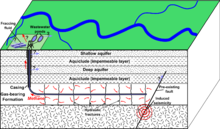From Wikipedia, the free encyclopedia
"Fracking" redirects here. For other uses, see Fracking (disambiguation).
| Hydraulic fracturing | |
|---|---|
| Process type | Mechanical |
| Industrial sector(s) | Mining |
| Main technologies or sub-processes | Fluid pressure |
| Product(s) | Natural gas Petroleum |
| Inventor | Floyd Farris; J.B. Clark (Stanolind Oil and Gas Corporation) |
| Year of invention | 1947 |
Hydraulic fracturing is the propagation of fractures in a rock layer by a pressurized fluid. Some hydraulic fractures form naturally -- certain veins or dikes are examples -- and can create conduits along which gas and petroleum from source rocks may migrate to reservoir rocks. Induced hydraulic fracturing or hydrofracturing, commonly known as fracing, fraccing, orfracking, is a technique used to release petroleum, natural gas (including shale gas, tight gas, and coal seam gas), or other substances for extraction.[1] This type of fracturing creates fractures from a wellbore drilled into reservoir rock formations.
The first use of hydraulic fracturing was in 1947 but the modern fracturing technique, called horizontal slickwater fracturing, that made the extraction of shale gas economical was first used in 1998 in the Barnett Shale in Texas.[1][2][3] The energy from the injection of a highly pressurized hydraulic fracturing fluid creates new channels in the rock, which can increase the extraction rates and ultimate recovery of hydrocarbons.
Proponents of hydraulic fracturing point to the economic benefits from vast amounts of formerly inaccessible hydrocarbons the process can extract.[4] Opponents point to potentialenvironmental impacts, including contamination of ground water, risks to air quality, the migration of gases and hydraulic fracturing chemicals to the surface, surface contamination from spills and flowback and the health effects of these.[5] For these reasons hydraulic fracturing has come under scrutiny internationally, with some countries suspending or banning it.[6][7]





0 comentarios:
Publicar un comentario